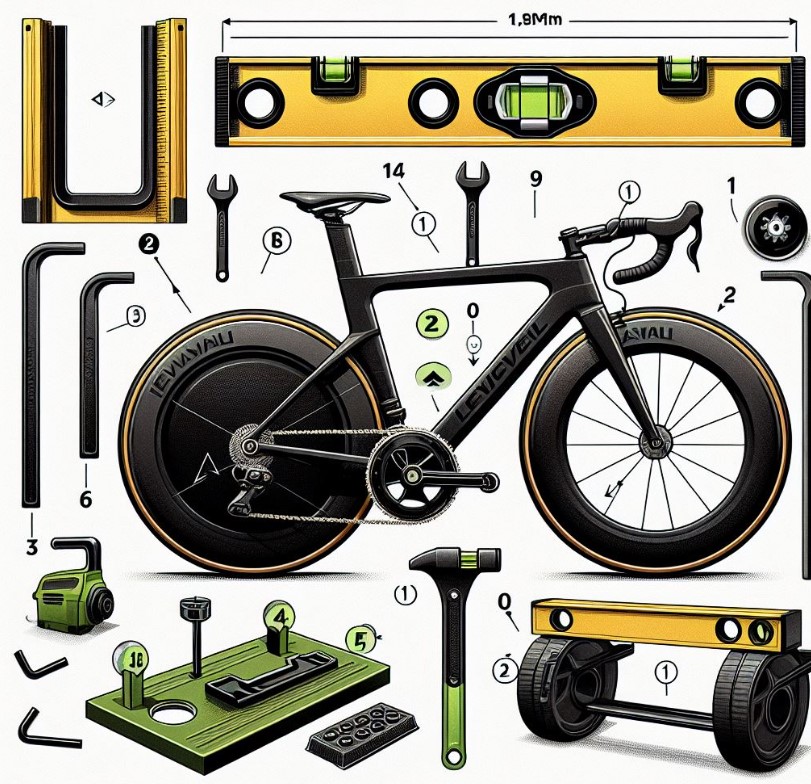How To Level Peloton Bike? All You Need To Know
Ensuring your Peloton bike is perfectly leveled is crucial for a safe, effective, and enjoyable workout experience. An unlevel bike can lead to discomfort, potential injuries, and even damage to your equipment. So, How To Level Peloton Bike? is more straightforward than you might think, and doing it correctly enhances your ride’s quality and your overall fitness journey.
Key Takeaways
- Ensuring your Peloton bike is level improves safety, comfort, and workout effectiveness.
- Use the built-in leveling feet on your bike for adjustments.
- Regular checks and adjustments are necessary for maintaining the optimal level.
- A spirit level can be an invaluable tool for accuracy.
How To Level Peloton Bike?
To level a Peloton bike, follow these straightforward steps:
- Place the Bike on a Flat Surface: Ensure the area where you intend to set up the bike is as level and flat as possible.
- Adjust the Leveling Feet: Locate the leveling feet at the base of the bike. These are adjustable knobs or screws that can be found at the front and rear stabilizers of the bike.
- Check for Stability: Manually press down on different sides of the bike to see if it wobbles or shifts. If there is movement, the bike is not level.
- Make Adjustments: Turn the leveling feet clockwise to raise the bike or counter-clockwise to lower it. Adjust these feet individually until the bike is stable and no longer wobbles. You may need to go back and forth between the different feet to get the bike perfectly level.
- Use a Spirit Level: For precise leveling, place a spirit level on the bike’s seat and handlebars. Adjust the leveling feet until the spirit level indicates that the bike is perfectly horizontal.
- Final Check: Once adjustments are made, give the bike another manual test to ensure there is no movement and the bike feels stable.

By following these steps, you’ll ensure your Peloton bike is level, providing a stable and safe platform for your workouts.
Ensuring Your Peloton Bike is Perfectly Level
Getting your Peloton bike to stand perfectly flat is essential for your cycling sessions. Not only does it prevent the bike from wobbling during intense workouts, but it also ensures that your posture remains correct, preventing unnecessary strain on your body. The process is simple and requires minimal tools.
Initial Setup and Adjustments
When setting up your Peloton bike, the first step is to find a suitable location. The floor should be as flat as possible. Once in place, you’ll need to adjust the leveling feet.
These are located at the base of the bike and can be turned clockwise or counter-clockwise to raise or lower each corner of the bike. It’s a trial and error process; adjust the feet until the bike stands firm without any wobble.
Using a Spirit Level for Precision
For those who seek perfection, using a spirit level can take the guesswork out of leveling your Peloton bike. Place the spirit level on the bike’s seat and handlebars to check the level. If the bubble isn’t centered, adjust the leveling feet accordingly until the bubble is in the middle, indicating that the bike is perfectly level.
Maintaining Your Bike’s Level
Your Peloton bike’s level should be checked regularly as the flooring or the bike’s position may change over time. Whether it’s due to intense workouts or the bike being moved, these factors can affect its level. Regular adjustments ensure that your bike remains stable and safe to use at all times.
Routine Checks
Incorporate a quick check of your bike’s level into your regular maintenance routine. Before each ride, give your bike a gentle shake to see if there’s any movement. If you notice any instability, adjust the leveling feet as needed before you start your workout.
Importance of a Level Bike
A level bike ensures that you can focus on your workout without distraction or discomfort. It prevents uneven weight distribution, which can lead to muscle imbalances or strain. By keeping your bike level, you’re also protecting your investment, ensuring that your Peloton remains in good condition for years to come.
Additional Tips for a Smooth Ride
Beyond leveling, there are other factors to consider for an optimal Peloton experience. Ensuring your bike is in the right position, adjusting the seat and handlebars to fit your body, and keeping the equipment clean and well-maintained contribute to a better workout.
Bike Position and Ergonomics
The position of your Peloton bike in your space can affect your workout. Ensure it’s placed in a well-ventilated area to keep you cool. Adjusting the seat height and depth, along with the handlebar height, ensures that you ride in the most comfortable and ergonomically correct position.
Keeping Your Bike in Top Condition
Regular maintenance, such as tightening bolts and screws, lubricating moving parts, and keeping the bike clean, ensures your Peloton runs smoothly. This not only enhances your riding experience but also extends the lifespan of your equipment.
Can You Level A Peloton Bike?
Yes, you can level a Peloton bike to ensure stability during your workouts. Peloton bikes are designed with adjustable leveling feet at the base, allowing you to make precise adjustments until the bike is stable, with no wobble or tilt.
To level your bike, first, place it at the desired location on a hard, flat surface. Then, adjust the leveling feet by turning them clockwise to raise or counter-clockwise to lower the bike’s height until it feels stable.

You may need a spirit level to check that the bike is perfectly horizontal. Regularly checking the bike’s level is crucial, especially if it’s placed on carpeting that can compress over time or if the bike is moved to a different location.
This simple adjustment can significantly enhance your riding experience by providing a stable platform for your workouts, preventing injuries, and ensuring the longevity of your bike.
How Do You Align A Peloton Bike?
Aligning a Peloton bike involves ensuring that the bike is not only level but also positioned correctly for optimal performance and comfort during use. After leveling the bike, aligning it includes adjusting the seat, handlebars, and screen to suit your body dimensions and riding style.
To align the seat, you should adjust both its height and depth. The seat height should be set so that when you are seated on the bike, your leg has a slight bend (about a 25-35 degree angle) when the pedal is at its lowest point.
To adjust the seat depth, ensure that when you are seated, your knee is directly over the center of the pedal when the pedal is in the 3 o’clock position.

The handlebars should be adjusted for comfort, typically at or slightly above the height of the seat for beginners or those preferring a more upright position, and lower for experienced riders seeking a more aggressive posture.
Screen alignment is straightforward; it should be angled for easy viewing when seated in the riding position. These adjustments ensure that the bike is aligned with your body, reducing the risk of injury and increasing the effectiveness of your workouts.
What Height Should My Peloton Seat Be?
The height of your Peloton seat is crucial for ensuring a comfortable, efficient, and injury-free ride. The general guideline for determining the correct seat height is to stand next to the bike and adjust the seat to be level with your hip bone.
When you’re on the bike with your foot at the bottom of the pedal stroke (the 6 o’clock position), your knee should have a slight bend, approximately 25-35 degrees.
This positioning helps optimize your pedaling efficiency, reduce strain on your knees, and prevent discomfort during and after your workout. It’s also recommended to fine-tune this adjustment over several rides, as slight variations can significantly impact comfort and performance.
Remember, proper seat height is not just about leg extension but also ensuring that your entire body is positioned correctly on the bike to facilitate effective breathing and engagement of the correct muscle groups.
Conclusion
Leveling your Peloton bike is a simple yet crucial step in ensuring a safe, effective, and enjoyable workout. By following the steps outlined above and making regular adjustments, you can maintain the perfect level for your bike.
This not only enhances your riding experience but also contributes to your overall fitness goals. Remember, a level Peloton bike is the foundation of every great ride, ensuring stability, comfort, and performance. Keep it level, and you’ll be set for success in every session.
Frequently Asked Questions
How can I make fine adjustments to the leveling feet?
To make fine adjustments to the leveling feet, turn them slightly in either direction to raise or lower each corner of the bike. It’s a delicate process, so make small adjustments and check the level frequently until it’s just right.
What is the best surface to place my Peloton bike on?
The best surface for a Peloton bike is a hard, flat, and stable surface. Hardwood floors, concrete, or a high-quality exercise mat are ideal. These surfaces help ensure that the bike remains level and stable during use.
Can the leveling feet on a Peloton bike wear out over time?
Yes, the leveling feet on a Peloton bike can wear out over time, especially with frequent adjustments or if the bike is used on a rough surface. Regularly inspect the feet for signs of wear and contact Peloton support if replacements are needed.
Is there a risk of damaging my Peloton bike if it’s not level?
Yes, using a Peloton bike that is not properly leveled can lead to uneven wear and tear on the bike’s components, potentially shortening its lifespan. It can also increase the risk of injury to the rider due to improper posture during workouts.

Welcome to the exhilarating world of Matt Rex, a professional car racer turned renowned vehicle enthusiast. Immerse yourself in his captivating blog as he shares heart-pounding adventures, expert reviews, and valuable insights on cars, trucks, jets, and more. Fuel your passion for speed and discover the beauty of vehicles through Matt’s engaging stories and meticulous expertise. Join the ever-growing community of enthusiasts who find inspiration and expert advice in Matt Rex’s blog—a digital hub where the thrill of speed meets the pursuit of knowledge.







